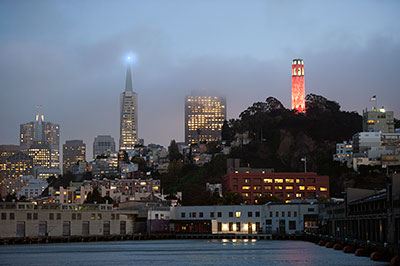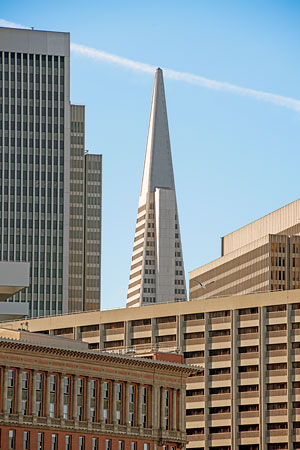San Francisco Points of Interest
Transamerica Pyramid
600 Montgomery Street
Financial District
Built 1969-1972
Height: 853 feet
Number of Floors: 48
Architect: William Pereira
The Transamerica Pyramid stands on the site of the Montgomery Block (California Historical Landmark 80) which was demolished in 1959 and replaced by a parking lot.
The demolition of the "Monkey Block" in San Francisco followed by the demolition of Pennsylvania Station in New York City four years
later were catalysts for the architectural preservation movement.

Even before it was built, the Transamerica Pyramid had its detractors. Among them were Alan Temko, Herb Caen and the Telegraph Hill Dwellers.
Alan Temko, architecture critic for the San Francisco Chronicle from 1961 to 1993, called the Transamerica Pyramid "the biggest architectural dunce cap in the world."
Chronicle columnist Herb Caen wrote on 21 October 1979:
The time has come, as the late Supervisor James B. McSheehy once said, "to grab the bull by the tail and look the facts in the face" about such issues as the race for Mayor, height limits and rent control....It was McSheehy who also said that a certain structure had "all the earmarks of an eyesore," a phrase that might apply to the Transamerica Pyramid....
Old San Francisco - the one so many nostalgics yearn for - had buildings that related well to each other.
You can see the evidence today among the apartment houses on Geary, Post and Sutter.
Along Grant Avenue: Shreve and Brooks Bros., Saks, that magnificent pillared phone building, the Baldwin Hotel.
Around Post and along Powell, the Chancellor, Elks, the old Press Club, 490 Post. Nearby, I. Magnin, Macy's, the old City of Paris, 133 Geary, J. Magnin.
At the foot of Market, the magnificent PG&E, old Southern Pacific, old Matson - all these buildings have a delicate relationship, "a decent regard" for each other.
All are low-rise. Not one is what Allan Jacobs, our one-time Planning Director and implacable foe of Transamerica, calls a "look-at-me" building."
In the June 1970 issue of the Telegraph Hill Dwellers newsletter, Curtis Baldwin wrote:
Transamerica would/will cast a morning shadow over the southern reaches of the Hill. Sunny patios and decks will become potential mushroom beds if this Twentieth Century Corporate Pharoah's pyramid is erected.

When the Transamerica Pyramid was completed in 1972, it was the tallest skyscraper in San Francisco and the eighth tallest building in the world.
The Pyramid failed to trigger the mushroom infestation predicted by the Telegraph Hill Dwellers, but the Dwellers did have a point about the Pyramid's Pharaonic dominance of the San Francisco skyline. Its unique siting makes it visible from almost any neighborhood in the northeast quadrant of San Francisco. Only the Sutro Tower exceeds the Pyramid in visibility.
The Transamerica Pyramid stands at the juncture of five neighborhoods: the Financial District, Jackson Square, Chinatown, North Beach and Telegraph Hill. Only the Financial District was zoned for highrise buildings. The other four neighborhoods had a sixty-five foot height limit. Even the old Monkey Block was zoned for sixty-five feet when the Pyramid was constructed.
The Transamerica Pyramid thus stands apart from - and taller than - nearby high rises in the Financial District and can be seen from many San Francisco historical sites:
- Condor Club
- Donaldina Cameron House
- Ghirardelli Building
- Golden Era Building
- Grogan-Lent-Atherton Building
- Hotaling Annex East
- Hotaling Annex West
- Hotaling Stables
- House of the Flag
- Independent Wood Company
- Medico-Dental Building
- Old Saint Mary's Church
- One Lombard Street
- Pelican Paper Company
- Sentinel Building
- Trinidad Bean & Elevator Company

